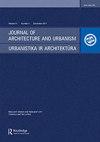SOCIAL PRODUCTION AND CONSUMPTION OF SPACE: STUDY OF PUBLIC-MARKET IN BANDUNG, INDONESIA
IF 0.6
0 ARCHITECTURE
引用次数: 0
Abstract
This paper aims to examine the role of architecture in social production and consumption of space, using public markets –architectural artifacts with rich social contents– as cases. This research adopts Low’s (2017) concept of social production of space and Dovey’s (2010) social constructivism of place to uncover the social production and consumption of public markets’ space. Cihapit and Pamoyanan market in Bandung, Indonesia, are selected as research cases, due to their cultural contents, appealing to consumers from middle to upper class society. It is found several roles of architecture in social production and consumption of public market space: building typology and morphology signifies historical context of development; architectural buildings contributes to formalize trading activities and elevating social class of market traders; commodities zoning is organized based on functional and socio-historical consideration; spatial intensity is determined by access and commodities zoning; informal atmosphere emerges as a distinctive advantage of public markets; and spatial quality is relative depends on governance capacity. Although normative criteria for good design can be formulated, in practice, spatial quality of public market is relative and depends on its capacity for spatial governmentality. By exploring social production and consumption of space and place provides broader perspective on the social practices of architecture, emphasizing its contribution for social and humanity studies.空间的社会生产与消费:印度尼西亚万隆公共市场研究
本文旨在以具有丰富社会内容的建筑人工制品--公共市场为案例,探讨建筑在空间的社会生产和消费中的作用。本研究采用 Low(2017)的空间社会生产概念和 Dovey(2010)的场所社会建构主义,来揭示公共市场空间的社会生产和消费。研究选取了印度尼西亚万隆的 Cihapit 和 Pamoyanan 市场作为研究案例,因为这两个市场具有文化内涵,吸引了来自中上层社会的消费者。研究发现,建筑在公共市场空间的社会生产和消费中扮演着多种角色:建筑类型和形态标志着发展的历史背景;建筑有助于使交易活动正规化并提升市场交易者的社会阶层;商品分区是基于功能和社会历史考虑而组织的;空间强度由交通和商品分区决定;非正式氛围成为公共市场的独特优势;空间质量相对取决于治理能力。虽然可以制定良好设计的规范标准,但在实践中,公共市场的空间质量是相对的,取决于其空间治理能力。通过探讨空间和场所的社会生产与消费,为建筑的社会实践提供了更广阔的视角,强调了其对社会和人文研究的贡献。
本文章由计算机程序翻译,如有差异,请以英文原文为准。
求助全文
约1分钟内获得全文
求助全文
来源期刊

Journal of Architecture and Urbanism
ARCHITECTURE-
CiteScore
1.30
自引率
14.30%
发文量
12
审稿时长
15 weeks
期刊介绍:
The Journal of Architecture and Urbanism publishes original research on all aspects of urban architecture.
 求助内容:
求助内容: 应助结果提醒方式:
应助结果提醒方式:


